Abstract
Conventional radiochromatographic procedures for the quantitation of carcinogen/mutagen-induced structural DNA modifications have a number of limitations. Thus, these techniques for the most part require application of radioactively labeled carcinogens and the use of relatively large amounts of DNA for analysis at low levels of DNA modification. Radiochromatographic methods also preclude analyses at the level of single cells and DNA molecules. Recently developed immunoanalytical methods have improved this situation considerably. Monoclonal antibodies (Mab) characterized by a high substrate specificity and affinity, in combination with radio- and enzyme-immunoassays, or with "immuno-slot-blot" techniques, now permit the detection of femtomole to subfemtomole amounts of, e.g., alkyldeoxynucleosides in small samples of DNA isolated from tissues or cultured cells previously exposed to nonradioactive N-nitroso compounds. Furthermore, selected Mab can be used to quantitate by direct immunofluorescence (with the aid of computer-based image analysis of electronically intensified fluorescence signals), specific alkyldeoxynucleosides in the nuclear DNA of single cells. With this method, the detection limit for the alkylation product O6-ethyldeoxyguanosine (O6-EtdGuo) is presently of the order of 10(2) -10(3) O6-EtdGuo residues per diploid mammalian genome. Individual cells can thus be monitored for the presence of specific carcinogen-DNA adducts, and with respect to their capacity for enzymatic removal of such modified structures from DNA (as exemplified here by the kinetics of the enzymatic elimination of O6-EtdGuo from the DNA of malignant neurogenic rat cell lines). In combination with transmission electron microscopy, Mab also permit direct visualization (via Mab binding sites) of specific carcinogen-modified structures in individual DNA molecules.(ABSTRACT TRUNCATED AT 250 WORDS)
Full text
PDF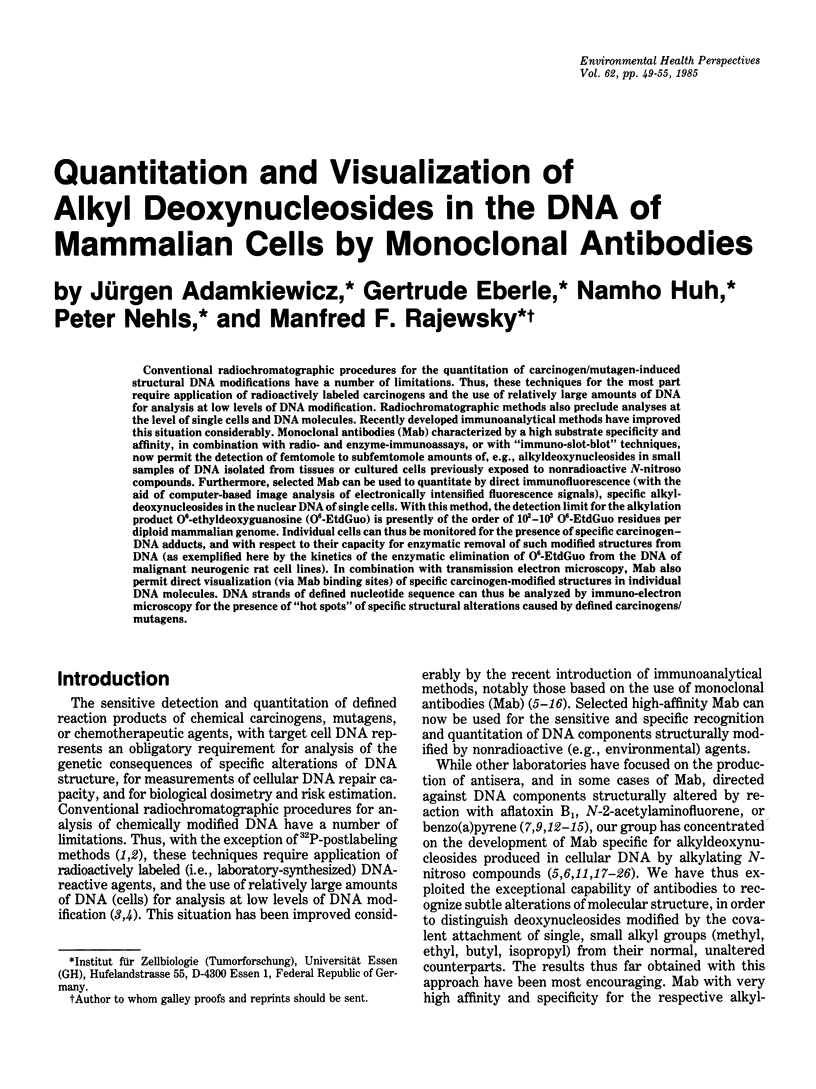
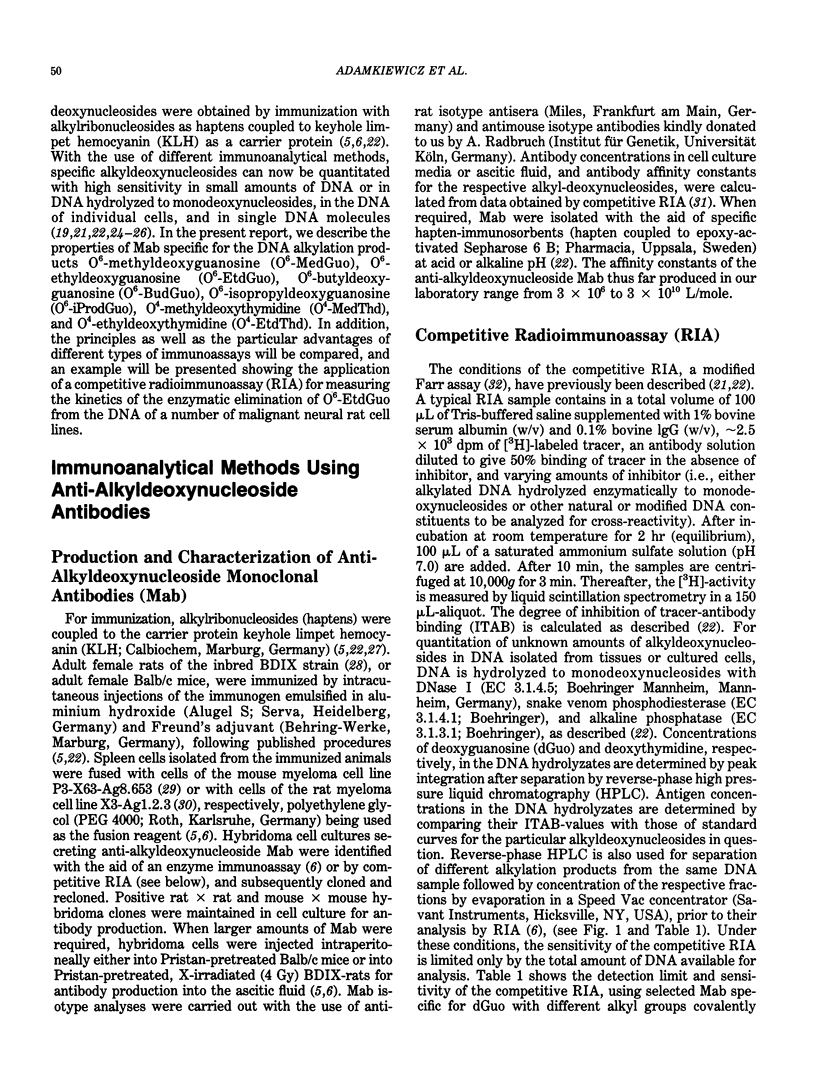
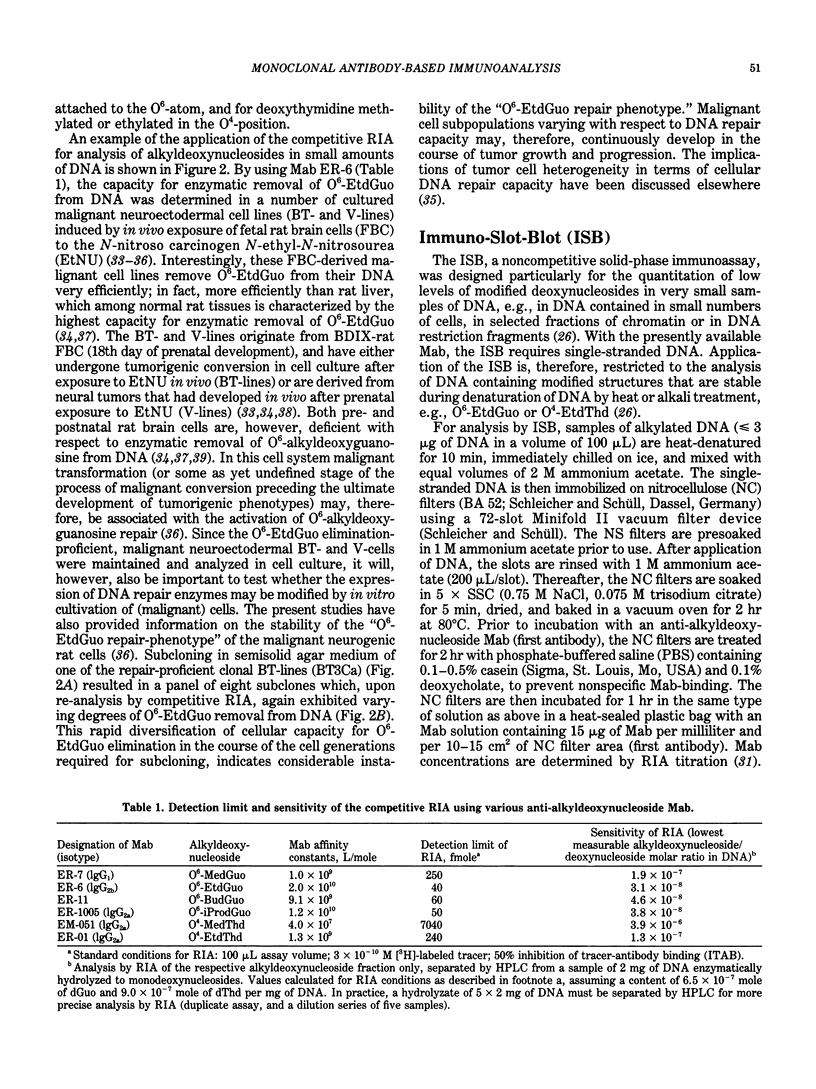
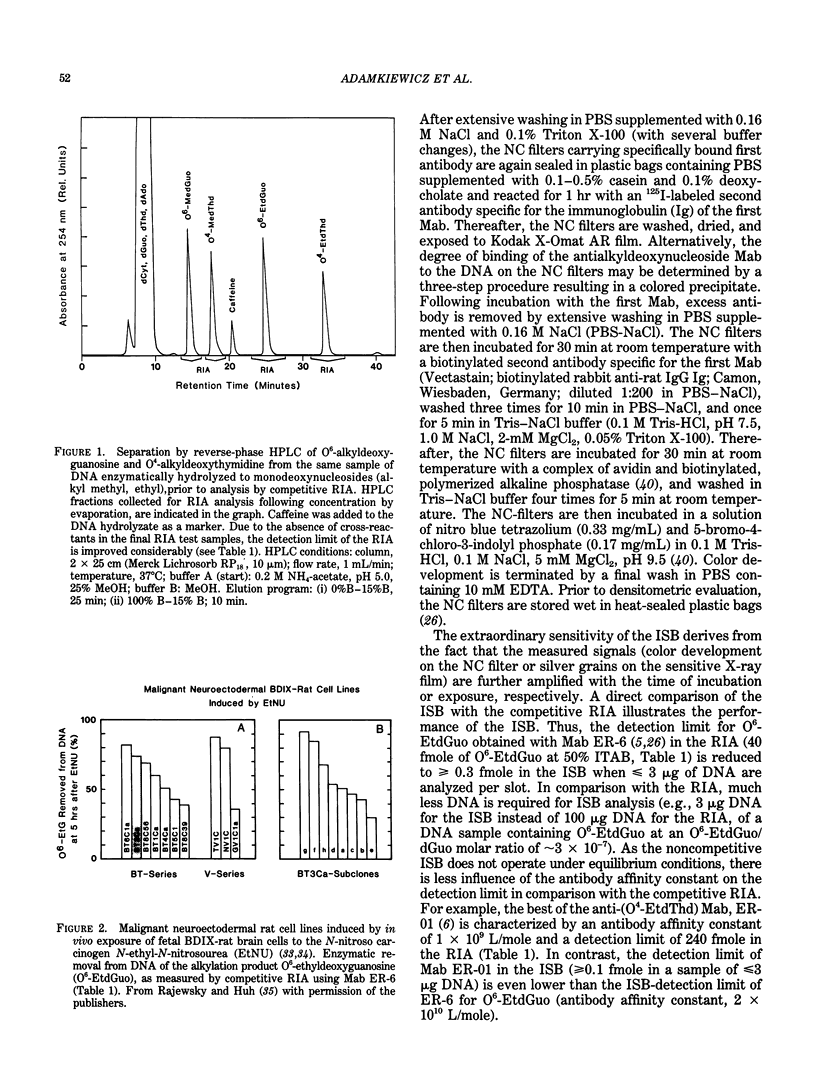
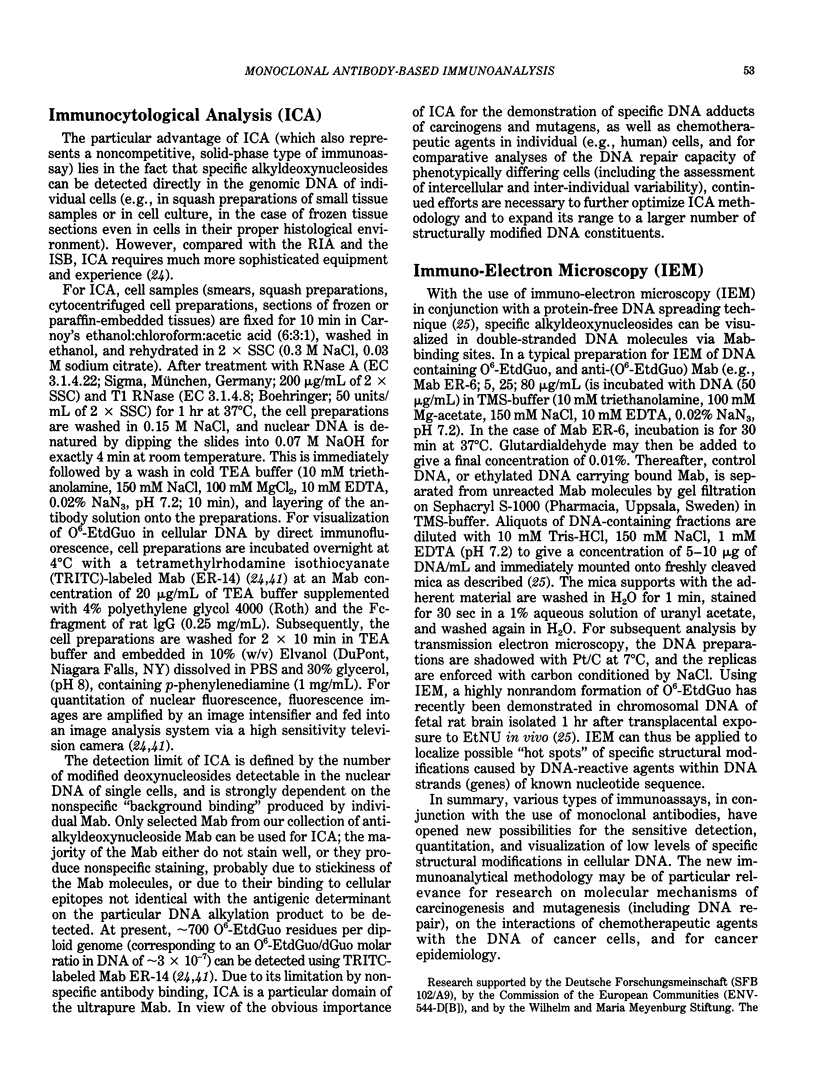
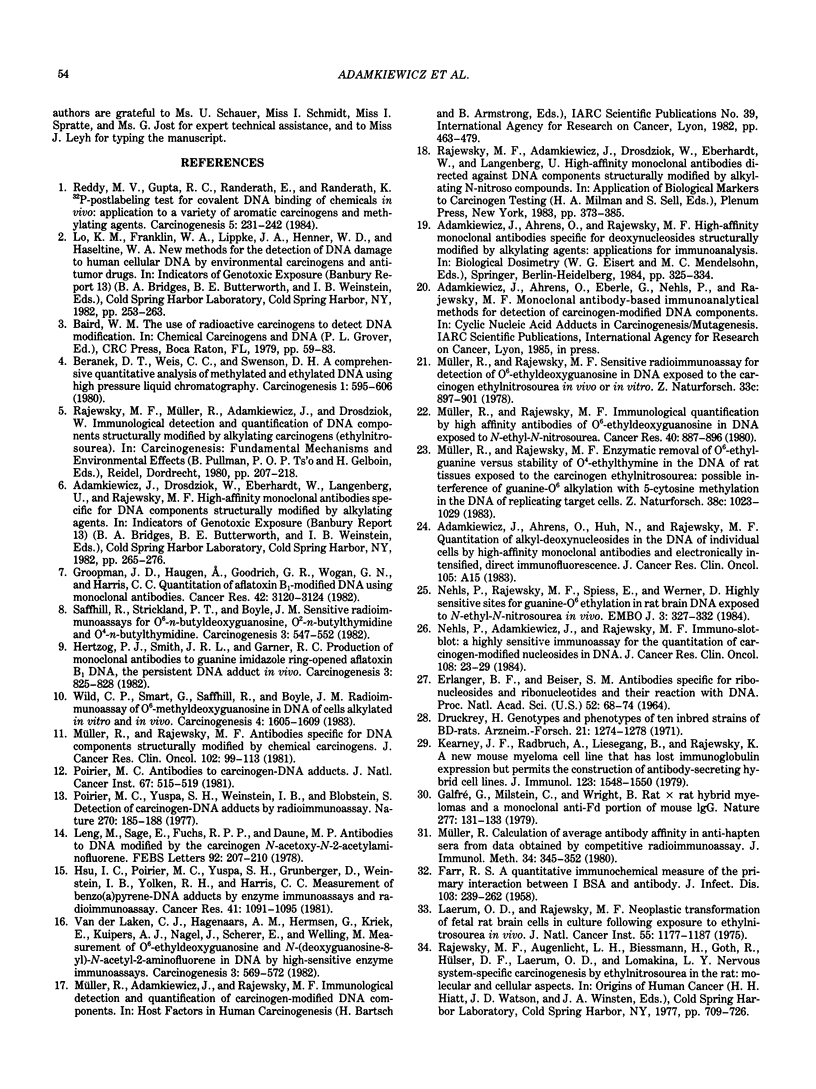
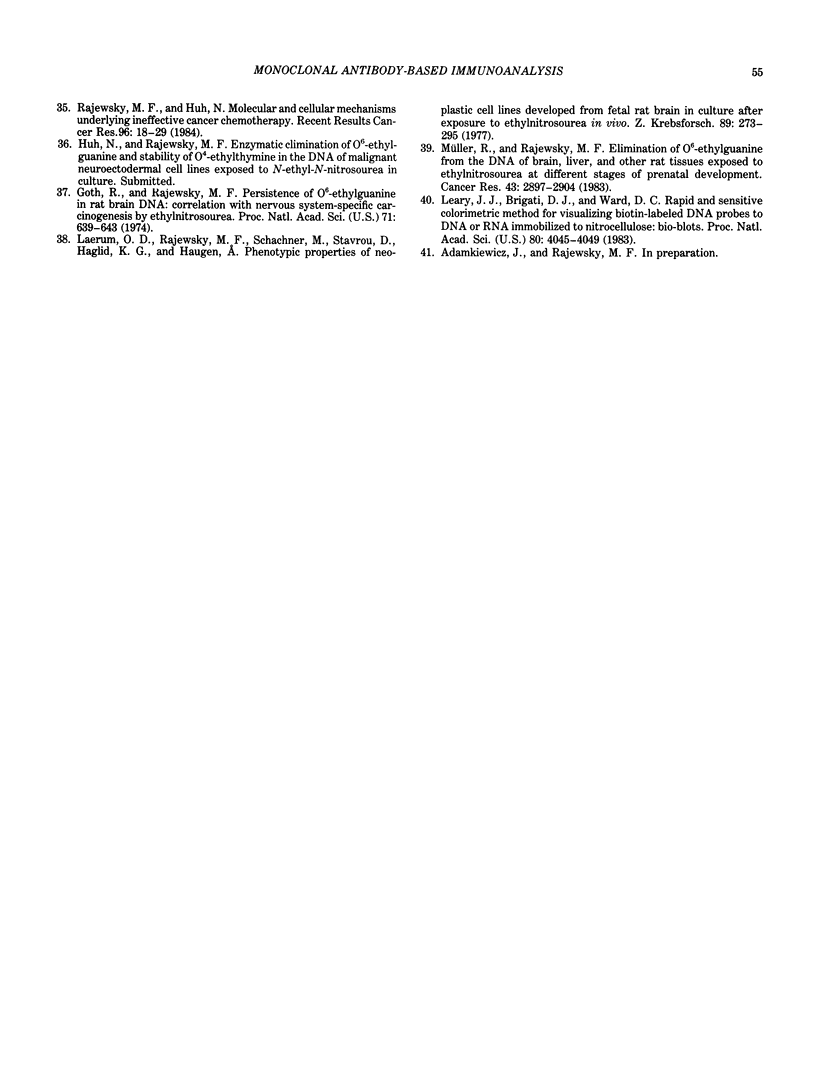
Selected References
These references are in PubMed. This may not be the complete list of references from this article.
- Beranek D. T., Weis C. C., Swenson D. H. A comprehensive quantitative analysis of methylated and ethylated DNA using high pressure liquid chromatography. Carcinogenesis. 1980 Jul;1(7):595–606. doi: 10.1093/carcin/1.7.595. [DOI] [PubMed] [Google Scholar]
- Druckrey H. Genotypes and phenotypes of ten inbred strains of BD-rats. Arzneimittelforschung. 1971 Aug;21(8):1274–1278. [PubMed] [Google Scholar]
- ERLANGER B. F., BEISER S. M. ANTIBODIES SPECIFIC FOR RIBONUCLEOSIDES AND RIBONUCLEOTIDES AND THEIR REACTION WITH DNA. Proc Natl Acad Sci U S A. 1964 Jul;52:68–74. doi: 10.1073/pnas.52.1.68. [DOI] [PMC free article] [PubMed] [Google Scholar]
- FARR R. S. A quantitative immunochemical measure of the primary interaction between I BSA and antibody. J Infect Dis. 1958 Nov-Dec;103(3):239–262. doi: 10.1093/infdis/103.3.239. [DOI] [PubMed] [Google Scholar]
- Galfrè G., Milstein C., Wright B. Rat x rat hybrid myelomas and a monoclonal anti-Fd portion of mouse IgG. Nature. 1979 Jan 11;277(5692):131–133. doi: 10.1038/277131a0. [DOI] [PubMed] [Google Scholar]
- Goth R., Rajewsky M. F. Persistence of O6-ethylguanine in rat-brain DNA: correlation with nervous system-specific carcinogenesis by ethylnitrosourea. Proc Natl Acad Sci U S A. 1974 Mar;71(3):639–643. doi: 10.1073/pnas.71.3.639. [DOI] [PMC free article] [PubMed] [Google Scholar]
- Groopman J. D., Haugen A., Goodrich G. R., Wogan G. N., Harris C. C. Quantitation of aflatoxin B1-modified DNA using monoclonal antibodies. Cancer Res. 1982 Aug;42(8):3120–3124. [PubMed] [Google Scholar]
- Hertzog P. J., Smith J. R., Garner R. C. Production of monoclonal antibodies to guanine imidazole ring-opened aflatoxin B1DNA, the persistent DNA adduct in vivo. Carcinogenesis. 1982;3(7):825–828. doi: 10.1093/carcin/3.7.825. [DOI] [PubMed] [Google Scholar]
- Hsu I. C., Poirier M. C., Yuspa S. H., Grunberger D., Weinstein I. B., Yolken R. H., Harris C. C. Measurement of benzo(a)pyrene-DNA adducts by enzyme immunoassays and radioimmunoassay. Cancer Res. 1981 Mar;41(3):1091–1095. [PubMed] [Google Scholar]
- Kearney J. F., Radbruch A., Liesegang B., Rajewsky K. A new mouse myeloma cell line that has lost immunoglobulin expression but permits the construction of antibody-secreting hybrid cell lines. J Immunol. 1979 Oct;123(4):1548–1550. [PubMed] [Google Scholar]
- Laerum O. D., Rajewsky M. F. Neoplastic transformation of fetal rat brain cells in culture after exposure to ethylnitrosourea in vivo. J Natl Cancer Inst. 1975 Nov;55(5):1177–1187. doi: 10.1093/jnci/55.5.1177. [DOI] [PubMed] [Google Scholar]
- Laerum O. D., Rajewsky M. F., Schachner M., Stavrou D., Haglid K. G., Haugen A. Phenotypic properties of neoplastic cell lines developed from fetal rat brain cells in culture after exposure to ethylnitrosourea in vivo. Z Krebsforsch Klin Onkol Cancer Res Clin Oncol. 1977 Aug 15;89(3):273–295. doi: 10.1007/BF00283783. [DOI] [PubMed] [Google Scholar]
- Leary J. J., Brigati D. J., Ward D. C. Rapid and sensitive colorimetric method for visualizing biotin-labeled DNA probes hybridized to DNA or RNA immobilized on nitrocellulose: Bio-blots. Proc Natl Acad Sci U S A. 1983 Jul;80(13):4045–4049. doi: 10.1073/pnas.80.13.4045. [DOI] [PMC free article] [PubMed] [Google Scholar]
- Leng M., Sage E., Fuchs R. P., Duane M. P. Antibodies to DNA modified by the carcinogen N-acetoxy-N-2-acetylaminofluorene. FEBS Lett. 1978 Aug 15;92(2):207–210. doi: 10.1016/0014-5793(78)80755-8. [DOI] [PubMed] [Google Scholar]
- Müller R. Calculation of average antibody affinity in anti-hapten sera from data obtained by competitive radioimmunoassay. J Immunol Methods. 1980;34(4):345–352. doi: 10.1016/0022-1759(80)90107-6. [DOI] [PubMed] [Google Scholar]
- Müller R., Rajewsky M. F. Antibodies specific for DNA components structurally modified by chemical carcinogens. J Cancer Res Clin Oncol. 1981;102(2):99–113. doi: 10.1007/BF00410662. [DOI] [PubMed] [Google Scholar]
- Müller R., Rajewsky M. F. Elimination of O6-ethylguanine from the DNA of brain, liver, and other rat tissues exposed to ethylnitrosourea at different stages of prenatal development. Cancer Res. 1983 Jun;43(6):2897–2904. [PubMed] [Google Scholar]
- Müller R., Rajewsky M. F. Immunological quantification by high-affinity antibodies of O6-ethyldeoxyguanosine in DNA exposed to N-ethyl-N-nitrosourea. Cancer Res. 1980 Mar;40(3):887–896. [PubMed] [Google Scholar]
- Nehls P., Adamkiewicz J., Rajewsky M. F. Immuno-slot-blot: a highly sensitive immunoassay for the quantitation of carcinogen-modified nucleosides in DNA. J Cancer Res Clin Oncol. 1984;108(1):23–29. doi: 10.1007/BF00390969. [DOI] [PubMed] [Google Scholar]
- Nehls P., Rajewsky M. F., Spiess E., Werner D. Highly sensitive sites for guanine-O6 ethylation in rat brain DNA exposed to N-ethyl-N-nitrosourea in vivo. EMBO J. 1984 Feb;3(2):327–332. doi: 10.1002/j.1460-2075.1984.tb01806.x. [DOI] [PMC free article] [PubMed] [Google Scholar]
- Poirier M. C. Antibodies to carcinogen-DNA adducts. J Natl Cancer Inst. 1981 Sep;67(3):515–519. [PubMed] [Google Scholar]
- Rajewsky M. F., Huh N. Molecular and cellular mechanisms underlying ineffective cancer chemotherapy. Recent Results Cancer Res. 1984;96:18–29. doi: 10.1007/978-3-642-82357-2_3. [DOI] [PubMed] [Google Scholar]
- Reddy M. V., Gupta R. C., Randerath E., Randerath K. 32P-postlabeling test for covalent DNA binding of chemicals in vivo: application to a variety of aromatic carcinogens and methylating agents. Carcinogenesis. 1984 Feb;5(2):231–243. doi: 10.1093/carcin/5.2.231. [DOI] [PubMed] [Google Scholar]
- Saffhill R., Strickland P. T., Boyle J. M. Sensitive radioimmunoassays for O6-n-butyldeoxyguanosine, O2-n-butylthymidine and O4-n-butylthymidine. Carcinogenesis. 1982;3(5):547–552. doi: 10.1093/carcin/3.5.547. [DOI] [PubMed] [Google Scholar]
- Van Der Laken C. J., Hagenaars A. M., Hermsen G., Kriek E., Kuipers A. J., Nagel J., Scherer E., Welling M. Measurement of O6-ethyldeoxyguanosine and N-(deoxyguanosin-8-yl)-N-acetyl-2-aminofluorene in DNA by high-sensitive enzyme immunoassays. Carcinogenesis. 1982;3(5):569–572. doi: 10.1093/carcin/3.5.569. [DOI] [PubMed] [Google Scholar]
- Wild C. P., Smart G., Saffhill R., Boyle J. M. Radioimmunoassay of O6-methyldeoxyguanosine in DNA of cells alkylated in vitro and in vivo. Carcinogenesis. 1983 Dec;4(12):1605–1609. doi: 10.1093/carcin/4.12.1605. [DOI] [PubMed] [Google Scholar]


